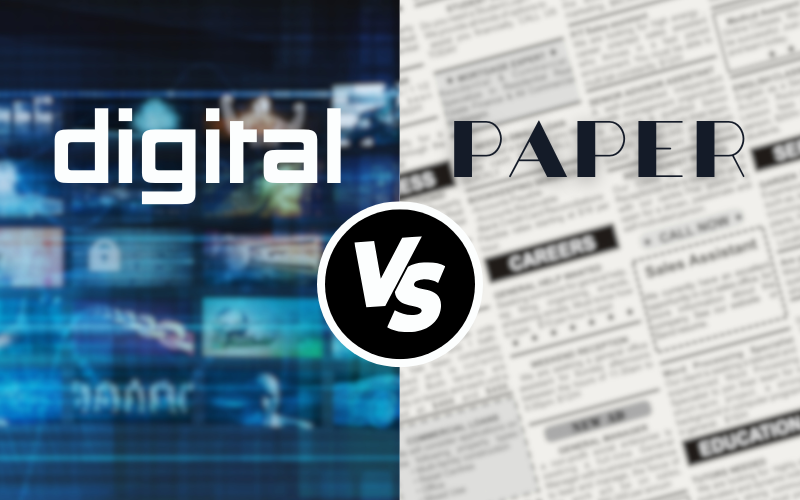Digital vs print advertising for healthcare is a key consideration for healthcare facilities looking to enhance their marketing efforts. With the ever-growing competition in the healthcare industry, facilities must find the most effective way to attract new patients, retain existing ones, and build a strong brand presence. The debate between digital and paper advertising is ongoing, with each method offering unique benefits.
Digital advertising provides precision targeting, cost efficiency, and measurable results, while paper advertising offers a tangible and trusted form of communication, particularly for local community outreach. The right choice depends on the facility’s goals, target audience, and budget. In this article, we will explore the pros and cons of both strategies to help healthcare marketers make an informed decision.

Table of Contents
Quick Comparison of Digital vs Print Advertising for Healthcare.
For those who don’t want to read the entire article, here’s a quick summary. Digital advertising is more cost-effective, provides detailed analytics, and offers better targeting and scalability. It is best suited for younger, tech-savvy audiences. Paper advertising builds trust, has a longer shelf life, and is effective for local community engagement, especially among older demographics. A combination of both methods can provide the best results, depending on the facility’s needs.
Features
Digital Advertising
- Broader reach with targeted ads (Google Ads, Facebook, LinkedIn)
- Cost-effective with real-time budget optimization
- SEO and content marketing for organic traffic
- Real-time analytics for campaign tracking
- Scalable for immediate needs like flu season
Paper Advertising
- Tangible and trustworthy for patients
- Effective for local community outreach
- Avoids digital clutter and competition
- Longer-lasting impression with printed materials
- Best for older demographics who prefer traditional media
Personal Experience
In my experience, digital advertising delivers more measurable results and scalability, making it a strong choice for healthcare marketing. When using digital advertising, the tool I use to create professional and eye-catching advertisements is Canva. If you would like to read my previously written article on this topic, you can find it here. However, printed brochures and flyers have been invaluable in community outreach efforts, particularly in senior living communities and local clinics.
Pricing
Digital advertising costs vary based on PPC campaigns but can be controlled in real time. Paper advertising, on the other hand, can have higher printing and distribution costs, but the investment may pay off in trust and long-term brand awareness.
Pros & Cons
Digital Advertising
One of the biggest advantages of digital advertising is that it is cost-effective and measurable. It offers immediate reach and targeting capabilities while also having SEO benefits that contribute to organic traffic. However, digital advertising can be complex to manage and requires continuous optimization to remain effective.
Paper Advertising
Paper advertising builds trust with tangible materials and has a longer shelf life. It also faces less competition compared to digital ads. However, it comes with higher production costs and limited targeting options.
Alternatives
Other marketing alternatives include television and radio ads, which offer a broader audience reach. Billboards and public transit ads can provide strong local visibility. A hybrid marketing strategy that combines digital and print efforts can maximize effectiveness.
Direct mail campaigns can also be effective, allowing healthcare facilities to send brochures, postcards, or newsletters directly to potential patients. Influencer marketing within the healthcare industry is another alternative, where healthcare professionals or patient advocates promote services through their online platforms. Community events and sponsorships can enhance brand awareness, while email marketing remains a cost-effective tool for nurturing patient relationships and sending important updates. Each of these alternatives can be integrated with digital or paper advertising to create a comprehensive marketing approach.
…
Conclusion: Which is better?
While digital advertising is generally more cost-effective and measurable, paper advertising still holds value for community engagement and trust-building. The best approach for healthcare facilities is often a mix of both, ensuring they reach all patient demographics effectively. The ultimate winner depends on the facility’s goals, audience, and budget.
To read an article about the ways paper beats digital marketing from Forbes, click here.


